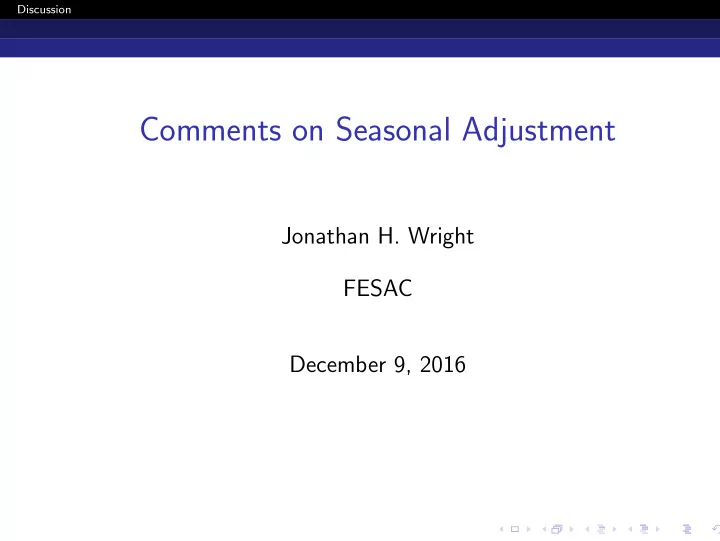

Discussion Comments on Seasonal Adjustment Jonathan H. Wright FESAC December 9, 2016
Discussion Introduction Direct v. Indirect Seasonal Adjustment Can do seasonal adjustment at aggregate or disaggregate level (Hood and Findley (2003)) Arguments for aggregate/direct ◮ What we care about most ◮ May work best if seasonal patterns correlated Arguments for disaggregate/indirect ◮ Preserves additivity and gives us “contributions decompositions” ◮ May work best if seasonal patterns not correlated
Discussion Introduction BEA Resolution (pre seasonality review) BEA resolution is a “corner solution”—seasonal adjustment at a very dissaggregate level ◮ SA on highly dissaggregated components ◮ SA at monthly frequency ◮ Do not SA some components ◮ Don’t compile data to let anyone do it otherwise
Discussion Introduction BEA Resolution (pre seasonality review) BEA resolution is a “corner solution”—seasonal adjustment at a very dissaggregate level ◮ SA on highly dissaggregated components ◮ SA at monthly frequency ◮ Do not SA some components ◮ Don’t compile data to let anyone do it otherwise My preference is for direct adjustment (Maravall (2006)), or at least some compromise
Discussion Introduction Can Direct and indirect be close? Direct and indirect have to be different because of nonlinearity in X-12 But difference can be small (Ladiray and Mazzi (2003)) Not if some of the disaggregates are not seasonally adjusted at all in indirect method
Discussion Introduction Residual Seasonality in topline GDP Regression with real GDP growth as dependent variable Variable Coefficient t-stat Constant 2.3 5.3 Lagged Growth 0.5 5.3 Q1 Dummy -2.0 -3.3 Q3 Dummy -1.2 -2.1 Q4 Dummy -1.0 -1.7 p -val for quarterly dummies: 0.013 Sample period: 1990Q1-2016Q3 Note data post 2012 are seasonally adjusted differently
Discussion Illustrative Simulation Toy Monte Carlo simulation Generate 100 series each of which is Gaussian white noise plus a small stable seasonal 120 “monthly” observations for each series The same seasonal for each of the 100 components Consider 3 approaches for SA of the sum over these 100 components ◮ Direct ◮ Indirect ◮ Indirect + Pretest (D8 F-test)
Discussion Illustrative Simulation Deterministic Seasonal Pattern 0.2 0.15 0.1 0.05 0 -0.05 -0.1 -0.15 -0.2 0 2 4 6 8 10 12 Month
Discussion Illustrative Simulation One of the 100 Disaggregates 3 2 1 0 -1 -2 -3 0 20 40 60 80 100 120
Discussion Illustrative Simulation The Aggregate Raw Series 0.4 0.3 0.2 0.1 0 -0.1 -0.2 -0.3 -0.4 -0.5 0 20 40 60 80 100 120
Discussion Illustrative Simulation The Aggregate SA Series 0.4 Direct Indirect 0.3 Indirect+Pretest 0.2 0.1 0 -0.1 -0.2 -0.3 -0.4 0 20 40 60 80 100 120
Discussion Illustrative Simulation Month-Averages of SA Series 0.2 Direct Indirect Indirect+Pretest 0.15 0.1 0.05 0 -0.05 -0.1 -0.15 -0.2 0 2 4 6 8 10 12 Month
Discussion Illustrative Simulation Just an Illustrative Story A Monte-Carlo simulation Not calibrated to look like economic data Entirely common seasonal pattern Oversimplification of how decision not to seasonally adjust would be made
Discussion Illustrative Simulation Just an Illustrative Story A Monte-Carlo simulation Not calibrated to look like economic data Entirely common seasonal pattern Oversimplification of how decision not to seasonally adjust would be made Still it reminds us that in indirect seasonal adjustment we should take account of the quality of the implied aggregate seasonal adjustment
Discussion Illustrative Simulation Monthly v Quarterly Issue of the level of aggregation for seasonal adjustment arises within time dimension too Adjusting monthly data and then aggregating to quarterly frequency is not the same as adjusting quarterly data McCulla and Smith (2015) cite this is an important cause of residual seasonality In toy Monte-Carlo example, of the 100 disaggregate series: ◮ 79 had no detected seasonality at monthly frequency ◮ 48 had no detected seasonality at quarterly frequency Maybe better to adjust NIPA data at the quarterly frequency
Discussion Illustrative Simulation Level of Disaggregation in Indirect SA Not a choice between seasonally adjusting headline numbers and at the most disaggregate level Can go in between In toy Monte-Carlo example, aggregating by a factor of 10, seasonality was detected in 9 of the 10 series
Discussion Conclusions Conclusions: Ways to mitigate residual seasonality Be wary of not seasonally adjusting a disaggregate ◮ BEA now seasonally adjusts more series (e.g. some inventory investment series) ◮ But criteria for residual seasonality in their review seem very stringent (e.g. F-test of 7) Seasonal adjustment could be done at quarterly frequency uniformly Seasonal adjustment could be at a lower aggregation level Publishing NSA data will let users do direct seasonal adjustment ◮ Scheduled for 2018
Recommend
More recommend